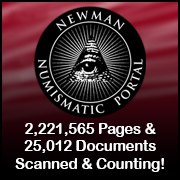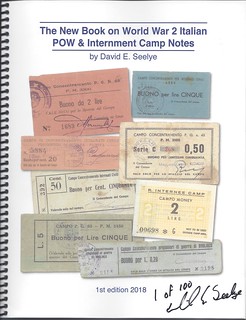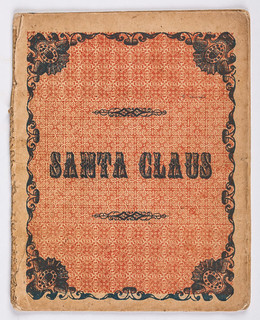
About UsThe Numismatic Bibliomania Society is a non-profit association devoted to the study and enjoyment of numismatic literature. For more information please see our web site at coinbooks.org SubscriptionsThose wishing to become new E-Sylum subscribers (or wishing to Unsubscribe) can go to the following web page link MembershipThere is a membership application available on the web site Membership Application To join, print the application and return it with your check to the address printed on the application. Print/Digital membership is $40 to addresses in the U.S., and $60 elsewhere. A digital-only membership is available for $25. For those without web access, write to: Terry White, Treasurer AsylumFor Asylum mailing address changes and other membership questions, contact Terry at this email address: terrywhite5475@yahoo.com SubmissionsTo submit items for publication in The E-Sylum, write to the Editor at this address: whomren@gmail.com BUY THE BOOK BEFORE THE COINSale Calendar |
- WAYNE'S WORDS: THE E-SYLUM DECEMBER 23, 2018
- DO THIS AND COLLECT FOR DECADES
- KOLBE & FANNING SALE 151 JANUARY 26, 2018
- NEW BOOK: WWII ITALIAN INTERNMENT CAMP NOTES
- PERIODICAL: THE HISTORICAL MEDAL JOURNAL
- BOOK REVIEW: MEGA RED 4TH EDITION
- GIJSBERTUS WILLEM DE WIT (1926-2018)
- KLEEBERG’S NUMISMATIC FINDS OF THE AMERICAS
- MORE ON WILLIAM A. PETTIT
- NOTES FROM E-SYLUM READERS: DECEMBER 23, 2018
- HOW MUCH 125 POUNDS IS WORTH TODAY
- VOCABULARY TERM: BIMETALLIC
- RICHARD WELLINGTON WILLIAMS (1853-1909)
- HARVEY STACK'S NUMISMATIC FAMILY, PART 33
- TOM URAM APPOINTED CCAC CHAIR
- INTERVIEW WITH ANNE JESSOP OF THE ROYAL MINT
- COIN EXHIBITION IN PUNE, INDIA
- SELECTIONS FROM RAY CZAHOR MAILBID SALE XXII
- NUMISMATIC NUGGETS: DECEMBER 23, 2018
- MORE ON THE DAIRSIE HACKSILVER HOARD
- HUNGARY COMPLETES BANKNOTE REDESIGN ROLLOUT
- LOOSE CHANGE: DECEMBER 23, 2018
- WAYNE'S NUMISMATIC DIARY: DECEMBER 23, 2018
- AAS ACQUIRES FIRST ILLUSTRATED VISIT FROM ST. NICK
- THE TWELVE COIN COLLECTING DAYS OF CHRISTMAS
- OXFORD NUMISMATIC SOCIETY CHRISTMAS GREETING
Click here to access the complete archive
Click here to unsubscribe (scroll down)
To comment or submit articles, reply to whomren@gmail.com
Content presented in The E-Sylum is not necessarily researched or independently fact-checked, and views expressed do not necessarily represent those of the Numismatic Bibliomania Society.
WAYNE'S WORDS: THE E-SYLUM DECEMBER 23, 2018
 New subscribers this week include: Sam Gill, courtesy of Tom Uram; Welcome aboard! We now have 5,816 subscribers.
New subscribers this week include: Sam Gill, courtesy of Tom Uram; Welcome aboard! We now have 5,816 subscribers.
Thank you for reading The E-Sylum. If you enjoy it, please send me the email addresses of friends you think may enjoy it as well and I'll send them a subscription (but let me know if they are located in the European Union). Contact me at whomren@gmail.com anytime regarding your subscription, or questions, comments or suggestions about our content.
This week we open with a plug for The E-Sylum, a new book, a new periodical, and a review of Mega Red.
Other topics this week include Kleeberg's Numismatic Finds of the Americas, G.W. de Wit, William Pettit, R.W. Williams, Tom Uram, Anne Jessop, and several Numismatic Nuggets.
To learn more about WWI Internment Camp notes, the bracteates of the Staufer era, auction catalog consignor commentaries, the Roosevelt University Numismatic Education Program medal, bimetallic coins, the Samuel Wolfson Collection, coins and paper money used in the Philippines, and Hungary's new banknotes, read on. Have a great week, everyone!
Wayne Homren
Editor, The E-Sylum
DO THIS AND COLLECT FOR DECADES
Many thanks to Dave Bowers for his nice plug for The E-Sylum in his advice to new collectors in Jim Bisognani's NGC blog article published December 13, 2018. Thanks also to Martin Kaplan for passing this along. -Editor
Dave Bowers, Numismatist, Author and Co-Founder, Stack’s Bowers
"Go slowly. For starters, read the Guide Book of United States Coins from cover to cover, the narrative part. Then go back and re-read the front matter. Consider your
budget and, for the first year, spend just a part of it, no more than 10% or 20%. Remember that on the internet, you can spend all you have in an hour. If you plan to spend
$10,000 in the first year, buy several dozen coins, tokens, medals or banknotes, not just one or two expensive pieces. Buy slowly, as items are easier to buy than to sell. For
starters, in the first year, spend 20% of you budget on numismatic books. Join the American Numismatic Association. Subscribe to and read several periodicals. Read
eSylum, free on the Internet. Do this and you will still be collecting 10 years from now. A fine collection in any of these series, if carefully formed with
knowledge and held for the long term, has always yielded a profit. I know of no exceptions! This is true and is remarkable. Success is at your doorstep!"
To read the complete article, see:
Eighth Annual Market Review: Part 1 (https://www.ngccoin.com/news/article/7047/)
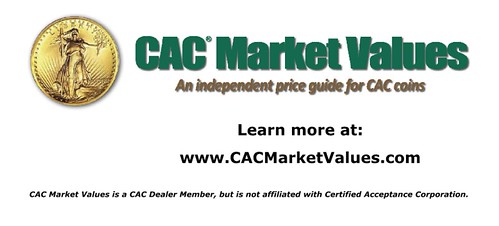
KOLBE & FANNING SALE 151 JANUARY 26, 2018
Here's the announcement for Kolbe & Fanning's next numismatic literature sale. Some important lots here - check out the catalog online and watch this space for more selections. -Editor
KOLBE & FANNING ANNOUNCE JANUARY 26 BOOK AUCTION
Kolbe & Fanning Numismatic Booksellers are announcing our Sale 151, which will be held on Saturday, January 26, 2019. The 500-lot sale covers ancient, foreign and U.S. numismatics, and includes selected items from over thirty different numismatic libraries, offering something for virtually all interests.
Some highlights of the sale include:
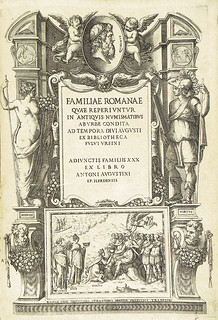
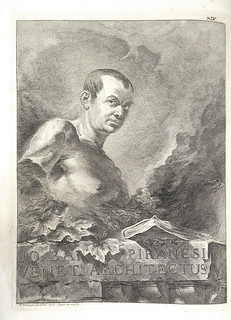
Lots 167 and 172
Lot 167: an exceptionally well-preserved copy of Fulvio Orsini’s foundational 1577 Familiae Romanae
Lot 172: Piranesi’s magnificent 1750 Opere Varie, bringing together 48 extraordinary engraved prints depicting the artist’s fantastical vision of the remnants of antiquity
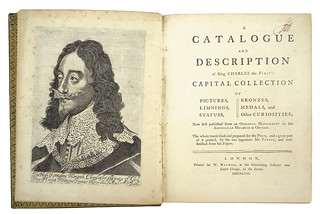
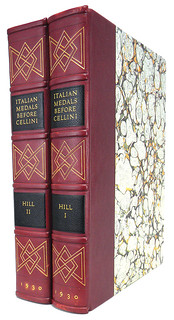
Lots 225 and 276
Lot 225: George Vertue’s rare 1757 catalogue of the collections of King Charles I, as edited by Horace Walpole
Lot 276: a beautifully bound set of Hill’s corpus of Renaissance medals
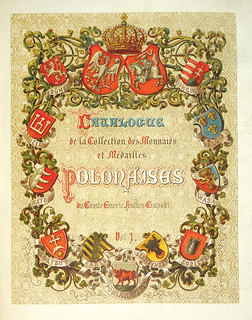
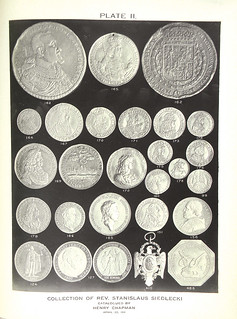
Lots 279 and 378
Lot 279: a complete original set of Count Hutten-Czapski’s very rare and important work on Polish coins and medals
Lot 378: a priced and named copy of the very scarce plated edition of Henry Chapman’s 1911 sale of the Stanislaus Siedlecki collection
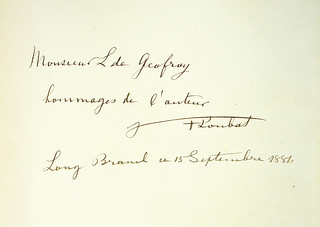
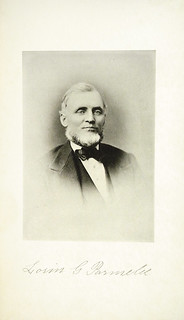
Lots 437 and 449
Lot 437: an inscribed set of the extremely rare 1881 edition of Loubat’s Medallic History of the United States of America
Lot 449: the New York Coin & Stamp Company’s 1890 Parmelee sale, in an original presentation binding with photographic plates.
Bids may be placed via post, email, fax or phone, as well as online. Kolbe & Fanning use Auction Mobility as our third-party online bidding platform. Auction Mobility is an app-based platform allowing users the ability to participate in the sale through phones, tablets and computers. To register for the sale, bidders must go to bid.numislit.com and sign up. Once you have set up an account, you may browse lots, place advance bids, or participate in the live sale online. Those wishing to participate on their devices can download the Kolbe & Fanning app through the Apple or Google Play Store.
The printed catalogue of Sale 151 will be mailed to active customers in the near future. A PDF of the printed catalogue has been posted to our main website at numislit.com for those who prefer that format. Bids placed via post, email, fax or phone must be received by January 25, the day before the sale, in order for them to be processed. Advance absentee bids may also be placed online at bid.numislit.com ; live internet bidding will be available during the sale itself through the same platform.
Kolbe & Fanning Numismatic Booksellers LLC is a licensed and bonded auction firm in the State of Ohio. For more information, please see the Kolbe & Fanning website at numislit.com or email David Fanning at df@numislit.com. To register for the sale, go to bid.numislit.com . We look forward to your participation.
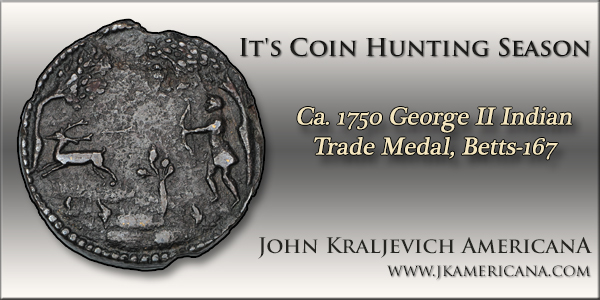
NEW BOOK: WWII ITALIAN INTERNMENT CAMP NOTES
Author David Seelye submitted this information about his new book on WWII Italian POW & Internment Camp notes. Congratulations! -Editor
In September 2018 I authored a new book on WW2 Italian POW & Internment camp notes. It is a 61 page book with full size, full color photos of my collection of these notes. There are four images from three other collectors. There has been nothing published in the field since Lance Campbell's second edition of Prisoner of War and Concentration Camp Money of the 20th Century 2nd edition 1993.
The catalog is on eBay at $34.99 item 173529366382.
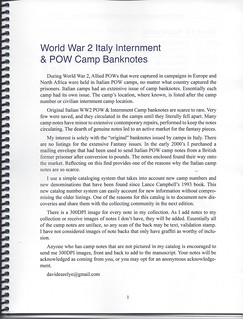

For more information, or to order, see:
The New Book on World War 2 Italian POW & Interment Camp Notes 1st Ed 2018
(https://www.ebay.com/sch/i.html?_from=R40&_trksid=m570.l1313&_nkw=173529366382&_sacat=0)
PERIODICAL: THE HISTORICAL MEDAL JOURNAL
A new journal on medals is being launched by the Historical Medallion Society. An article by Andrew Wiger in the December 2018 issue of Money & Medals (a newsletter for numismatics in Britain) describes the short history of the Society and announces its new publication. -Editor
In 2013 two numismatists with an interest in historical and commemorative medallions were lamenting, over lunch, the lack of any social forum in which to share that interest with like-minded individuals. They agreed that something along the lines of the successful series of Token Congresses would be ideal and decided to sound out the viability of such an idea. Enquiries established that there would be sufficient support for such an undertaking. As a result, a society – the Historical Medallion Society – was set up with the aims of promoting the study of historical medallions, disseminating the results of such study and, in particular, organising an annual congress to further these aims.
The first Congress was held at the Hilton Hotel in Warwick in 2014 and the sixth Congress will be held at the same venue on Saturday 8th June 2019. Warwick was chosen as a conveniently central location, accessible by car or train, and at a hotel that was familiar with the needs of numismatists as several successful Token Congresses had been held there. The format of the Token Congress was used as a model. Delegates gather on Saturday morning (or Friday evening if they are coming a further distance) and a range of talks are delivered during the day, punctuated by plentiful breaks for coffee and meals. After the evening meal delegates have the opportunity to attend a bourse and acquire new items for their collection. Most choose to stay overnight: there are no lectures on the Sunday but the date chosen usually coincides with the large coin fair at the National Motorcycle Museum a shortish car journey from the hotel.
More than 20 speakers have given papers at the five congresses held so far, with wide-ranging subjects covered. These include: famous medallists such as Leonard Wyon and Mary Gillick and manufacturers Matthew Boulton and Edward Thomason, and less well known figures such as Ada Dressler; medals relating to specific groups such as the British and Foreign Sailors Society, the Nipton Horseshoeing Medal and Agricultural Societies, and the Northampton Amateur Athletic Association and medals relating to specific subjects such as Brunel’s Ships, Parliament, London Bridges, and even the cement industry! The above will hopefully provide an indication of the varied and fascinating nature of the Congress programme.
This year we have decided to move to the next stage in the Medallion society’s evolution and publish a journal of research articles, based initially on some of the talks members have given in the first five congresses, but articles on any related topic will be considered for inclusion. The publication will be called the Historical Medal Journal (HMJ) and will be based on the format used by the Token Corresponding Society. The first issue will be given free to all those attending the 2019 congress. Anyone interested in contributing an article should contact the society at the email address below.
What the above does not fully communicate is the wonderful atmosphere of the congresses. Like its parent, the token congress, its success lies in people from a wide range of backgrounds, ages and interests coming together to share their common enthusiasm. It is in the informal conversations over coffee and in the bar often late into the night that some of the best ideas are shared, medallions traded and new friends made. Above all, it is just great fun. So, if you have not tried coming to a Congress, why not give it a try in 2019. You will be made very welcome. Further details can be obtained from John Cumbers the Congress secretary: medallioncongress14@gmail.com .
For more information on the Money & Network, see:
http://www.moneyandmedals.org.uk/

BOOK REVIEW: MEGA RED 4TH EDITION
Mike Thorne published a nice review of the 4th edition "Mega Red" in Numismatic News December 12, 2018. here's a short excerpt - be sure to read the complete article online. -Editor
 To say that the book I’m going to review in this column is gargantuan is an understatement. According to my postal scales, it rings in at a whopping 6 pounds 10.5
ounces. That would be a good weight for a newborn infant rather than a paperback book. If I don’t want to do my weights at the gym, I can always work out with Mega Red.
To say that the book I’m going to review in this column is gargantuan is an understatement. According to my postal scales, it rings in at a whopping 6 pounds 10.5
ounces. That would be a good weight for a newborn infant rather than a paperback book. If I don’t want to do my weights at the gym, I can always work out with Mega Red.
Seriously, this is the 4th edition of a giant of a book, A Guide Book of United States Coins Mega Red. As you can tell from the title, it’s related to the venerable A Guide Book of United States Coins, aka the Red Book. In fact, you can think of it as the Red Book on steroids.
To give you a picture of the difference in dime coverage between Mega Red and the Red Book, I measured and counted the pages. In the 2018 Red Book, dimes are treated on 16, 5.25- x 7.75-inch pages. In Mega Red, dimes are covered on 294, 6.5- x 10-inch pages. In other words, when you buy the latest Mega Red, it includes a complete book on U.S. dimes!
I hasten to add that of the Mega Red’s 25 appendices, 15 are about dimes in one way or another. These are not included in the page count I just gave you.
To read the complete article, see:
Mega Red 4th Edition a must-have
(https://www.numismaticnews.net/article/mega-red-4th-edition-a-must-have)
GIJSBERTUS WILLEM DE WIT (1926-2018)
Medieval coinage collector and researcher G. W. de Wit passed away. His collection was sold in three parts by the auction house Künker in 2007 and 2008. The following obituary was written by Fritz Rudolf Künker. -Editor
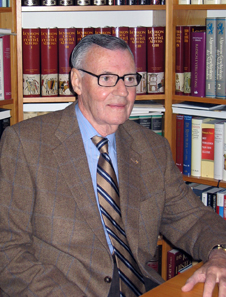 On December 1, 2018, Gijsbertus Willem de Wit passed away. He was first and foremost known to numismatists because of his extensive collection of medieval coins, which
was sold in three parts by the auction house Künker in 2007/8. According to Bernd Kluge and his work on medieval numismatics, it is regarded as “the most important comprehensive
collection of medieval coins sold in an auction since the Lord Grantley Collection (1855-1943).”
On December 1, 2018, Gijsbertus Willem de Wit passed away. He was first and foremost known to numismatists because of his extensive collection of medieval coins, which
was sold in three parts by the auction house Künker in 2007/8. According to Bernd Kluge and his work on medieval numismatics, it is regarded as “the most important comprehensive
collection of medieval coins sold in an auction since the Lord Grantley Collection (1855-1943).”
Prof. Gijsbertus Willem de Wit (he preferred to shorten his first name to G. W.) was born in Rotterdam on July 5, 1926. He taught physics at the University of Leiden in the Netherlands. From 1947 until his retirement, he worked at the “Nationale Levensverzekeringsbank” (later called Nationale-Nederlanden, now ING). At the same time, he taught insurance economics at the Erasmus University of Rotterdam.
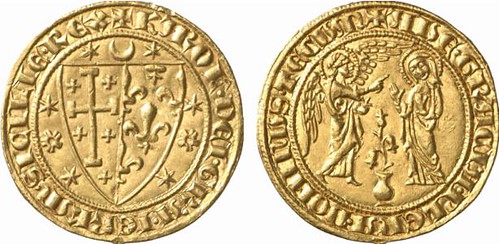
Charles I of Anjou. Saluto d’oro. Annunciation scene. Purchased in 1965 – the first coin of the de Wit Collection. Sold at Künker sale 137 (March 11, 2008), no 3761.
However, his true passion was numismatics. His journeys to Italy in the 1950s and 1960s inspired him. He was amazed by the medieval sacred art and, to his surprise, he noticed that the Annunciation could be purchased in miniature but contemporary format on a Salut d’or of Charles I of Anjou. That gold coin laid the foundation for a collection of medieval coins, which would make his name famous amongst numismatists all over the world.
Italy remained the focus of his collection, but he began developing an interest in English sceattas in 1967. The latter were later sold en bloc to the Fitzwilliam Museum in Cambridge. The bracteates of the Staufer era, which art connoisseurs celebrate as masterpieces of the Romanic period, became another focal point.
In 2004, at the age of 78, Professor de Wit decided to part with his collection. His one condition was that it had to be adequately published, so as to offer help to other collectors who attempt to read up on the complex field. That is the reason why he wrote the historical comments himself, which have proven to be important contributions to research in some cases.
Now, G. W. de Wit has passed away. But with his collection, he has left a legacy that numismatists will continue to praise for decades on.
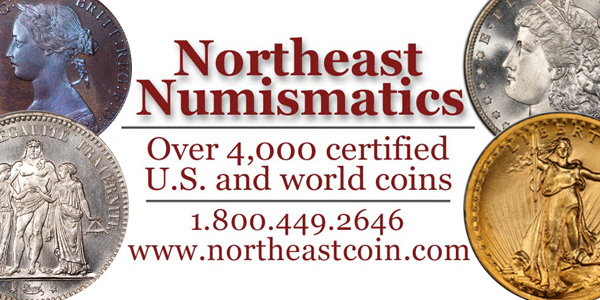
KLEEBERG’S NUMISMATIC FINDS OF THE AMERICAS
Newman Numismatic Portal Project Coordinator Len Augsburger provided the following report. Thanks. -Editor
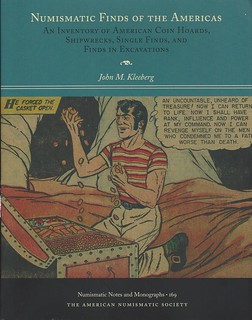 This week we highlight one of the most frequently consulted resources on Newman Portal, John Kleeberg’s Numismatic Finds of the Americas. This volume is no. 169
in the American Numismatic Society’s Numismatic Notes and Monographs series and was published in 2009. The dust jacket alone (representing a comic book adaptation of
The Count of Monte Cristo) is immediately arresting, but of course the real substance is found in between the covers. The work is divided into three parts, with Part I
providing summaries of 892 finds in North and South America. Part II covers accumulations and releases of silver dollars from the U.S. Treasury, while part III treats American
coins dug outside the Americas.
This week we highlight one of the most frequently consulted resources on Newman Portal, John Kleeberg’s Numismatic Finds of the Americas. This volume is no. 169
in the American Numismatic Society’s Numismatic Notes and Monographs series and was published in 2009. The dust jacket alone (representing a comic book adaptation of
The Count of Monte Cristo) is immediately arresting, but of course the real substance is found in between the covers. The work is divided into three parts, with Part I
providing summaries of 892 finds in North and South America. Part II covers accumulations and releases of silver dollars from the U.S. Treasury, while part III treats American
coins dug outside the Americas.
The strength of the work is the copious citations – documentation for every find is cited, and in many cases multiple references are provided. The summaries themselves will whet the appetite, and for the more curious reader Kleeberg points to further background. The only possible problem we can find with the work is that computer technology was not sufficiently advanced in 2009 to support GIS methods that provide geographical insights into hoard data – hardly the author’s fault. The Newman Portal acknowledges ANS for permitting scanning of this material, and congratulates John Kleeberg on receiving the ANS Huntington Award, which was conferred on December 4.
Link to Numismatic Finds of the Americas on Newman Portal:
https://nnp.wustl.edu/library/book/519183
Link to ANS periodicals on Newman Portal:
https://nnp.wustl.edu/library/periodicals?Tag=ANS
Link to ANS Numismatic Notes and Monographs on Newman Portal:
https://nnp.wustl.edu/library/publisherdetail/511479
MORE ON WILLIAM A. PETTIT
Last week Bill Seldon asked for information on William A. Pettit. -Editor
Dennis Forgue writes:
Bill went from Marshall Fields to work at Rarcoa in the mid 1960’s shortly after the formation of the company. He was there several years before I started in 1968. He ran the foreign coin department for Rarcoa. Bill had an amazing memory for Coins and History. He built the amazing foreign and ancient library that Rarcoa had until it moved to the suburbs and sold off though George Kolbe and the Money Tree auctions.
He could talk on almost any foreign coin you showed him, and had an incredible collection of coins. He was the Chairman of the 1st Chicago International Coin Fair that was created by Rarcoa. He went to work for Krause Publications to work and preparing the first of the telephone book sized World Coin books after leaving his employment in Chicago. He and his wife and two daughters moved to Iola where they stayed for many years. He was a good friend and well respected colleague.
Jeffrey S Zarit writes:
Bill Pettit Ran the world coin department for RARCOA while they were at 31 N Clark St in Chicago (now the home to HARLAN BERK (who was previously in Joliet, Ill.)) I remember doing some business with him in the early 1970's, while I was just starting out as a world coin dealer. His knowledge was great and he had no problem sharing with others. I also remember a talk he gave at the Morton Grove coin club about the possible state of Franklin in the 18th century. Only in the past couple of years have I read more about it and I remember his talk.
George Cuhaj writes:
William Pettit was a KP staff member in the Catalog Division. By the time I came to KP he had moved on and was the Director of the New London (WI) Public Museum. There is a memorial page dedication to him in one of the later 1990s century editions of the Standard Catalog of World Coins.
Clifford Mishler writes:
I first met Bill in the early 1960s, probably at a Chicago area event. He was a very active member of the Chicago Coin Club for many years, of which he was president in 1973-74.
In 1977 I hired Bill to join the world coin cataloging staff at Krause Publications in Iola, where he was engaged for roughly ten years, leaving the company in 1986. At that time he moved on to become curator of the historical collection and exhibition of the nearby New London Public Museum, where he was engaged from then until his passing in 1995. While engaged at Krause Publications he pursued a focused engagement with the development and refinement of the late 16th through 18th century listings incorporated in the Standard Catalog of World Coins, and contributed occasional by-lined articles in World Coin News.
I’m afraid that at this juncture I can not provide a more detailed insight into his interests and contributions to the numismatic realm.
One interesting insight into the depth and range of interests I’d like to share; he was also an active collector/accumulator of newspapers from around the country, and the world, with an interest in correlating their news contents to the world perspectives on the dates of their publication. While travelling overseas I invariably picked up newspapers in the cities visited, conveying them into his possession upon my return, where they were eagerly and appreciatively received.
He goes down as one of the most unassuming cerebral minds of the hobby that it has been my pleasure to meet and interact with on an ongoing basis
For more information on the New London Public Museum, see:
http://www.newlondonwi.org/departments/new_london_public_museum.php
Thanks, everyone, including Pete Smith who forwarded scans of the obituaries of William A. Pettit from Coin World of June 19, 1995, and Numismatic News from June 13, 1995. I passed these along to Bill Seldon. -Editor
To read the earlier E-Sylum article, see:
NOTES FROM E-SYLUM READERS: DECEMBER 16, 2018 : Query: William A. Pettit
(https://www.coinbooks.org/v21/esylum_v21n50a08.html)

NOTES FROM E-SYLUM READERS: DECEMBER 23, 2018
Alaska Earthquake Affects JR Newsletter Editor
In the December 16, 2018 issue of JR Newsletter, an electronic publication of the John Reich Collectors Society, Editor Richard Meaney wrote:
Many of you wrote and asked how I fared in the recent earthquake in Alaska. Seems the epicenter of the large quake was less than 15 miles from my home! My wife, daughter, dog, and I were all unharmed. We wish we could say the same for our home. Nearly every component of the house was damaged in some way, including floors, walls, windows, plumbing, stairs and stair rails, doors, and even various ceilings. Fortunately, the heat still works, we have were able to get some temporary fixes on some plumbing issues, and we can still live in the house. Another fortunate choice was to carry earthquake insurance. After we pay about $45,000, the insurance company will pick up the rest of the repair tab. So we are trying to look at it from the perspective of, "hey, we get our whole house updated (it was built in 2006) and it will cost just the price of a new SUV."
We're sorry to hear that news. Numismatists aren't immune from natural disasters, as we saw recently with the Paradise fire which hit researchers Rich Kelly and Nancy Oliver. Good luck with the repairs, and let us know how the numismatic community can help. -Editor
For information on the John Reich Collectors Society, see:
https://www.jrcs.org/
To read the earlier E-Sylum article, see:
FIRE AFFECTS AUTHORS RICH KELLY AND NANCY OLIVER (https://www.coinbooks.org/v21/esylum_v21n48a07.html)
More on Richard Margolis
Douglas Saville of Reading, England writes:
I knew Richard from 1970 when I joined Spinks in London - he was a credit to our subject, knowledgeable considerate and a gentle man. His ability as a coin dealer was formidable and along with a kind sense of humour, he made a significant mark amongst all involved in the areas in which he flourished - he will be missed, but his legacy will remain in his masterful research on Matthew Boulton and the portrait medals of Benjamin Franklin by Nini.
To read the earlier E-Sylum article, see:
NOTES FROM E-SYLUM READERS: DECEMBER 16, 2018 : On Richard Margolis
(https://www.coinbooks.org/v21/esylum_v21n50a08.html)
On Consignor Commentaries
Mike Hodder writes:
Seems like the best part of the magnificent Alan Weinberg Collection sales will be his commentaries on the lots included.
Memories are fallible and emotion can take hold, but on balance I agree that including properly labeled consignor commentary is a net positive for numismatic auction cataloging. There's no substitute for the meticulous research and writing of a professional cataloger, but comments and recollections of the owner add color and context unavailable elsewhere, and provide a great way to document how collections were formed, and the interactions with the collectors and dealers met along the journey. How great would it be to have such commentary from the Ropers, Mickleys, and Parmelees of the numismatic world? -Editor
To read the earlier E-Sylum article, see:
SELECTIONS FROM THE WEINBERG COLLECTION, PART 1 (https://www.coinbooks.org/v21/esylum_v21n50a15.html)
Psychological Warfare Currency
Herb Friedman writes:
I see mention of a book about money at war. I have written about 5-6 articles on the psychological warfare currency printed by warring countries during War. Here are two articles on the Allied and Axis propaganda and counterfeit banknotes during WWII. I have written other articles on Korea, Vietnam, and Desert Storm propaganda currency.
ALLIED BANKNOTES
http://www.psywarrior.com/WWIIAlliedBanknotes.html
AXIS BANKNOTES
http://www.psywarrior.com/WWIIGermanBanknotes.html
Thanks for the links. A fascinating numismatic specialty. -Editor
To read the earlier E-Sylum article, see:
NEW BOOK: OBJECTS OF WAR (https://www.coinbooks.org/v21/esylum_v21n50a03.html)
More on the Saudi Arabia Gold Discs
Mike Marotta submitted this book excerpt in response to our earlier discussions of the Saudi Arabia gold discs. Thank you.
Despite the well-researched myth-busting offered from J. P. Koning’s article at the BullionStar blog pages and reported here in The E-Sylum, I have to stick with the Aramco version on several grounds. Without going into all of it now, coincidentally, I am reading The Wise Men: Six Friends and the World They Made, by Walter Isaacson and Evan Thomas (Touchstone/Simon & Schuster, Inc., 1986.) The other morning, I read this passage (pages 572-573):
 Ever since World War II, the U.S. government had preferred to leave Middle East diplomacy to the oil companies and the bankers who financed Big Oil...
Ever since World War II, the U.S. government had preferred to leave Middle East diplomacy to the oil companies and the bankers who financed Big Oil...
Washington was torn by conflicting aims. An abundant supply of cheap oil was essential to the economy and national security. Friendly relations with the Arabs were necessary to keep them out of the Soviet orbit. Yet no Administration could politically afford to offend American Jews by appearing to help Israel’s mortal enemies in the Middle East. The solution: Let the oil companies take care of the Arabs, with the discreet aid or at least non-interference of the U.S. government.
[President Truman’s Secretary of State, Dean] Acheson had been perfectly frank about the oil companies’ role. “American oil operations are, for all practical purposes instruments of our foreign policy towards [Middle Eastern] countries,” he declared before leaving office in 1953. Eisenhower and [in-coming Secretary of State John Foster] Dulles simply maintained the Truman Administration’s benign hands-off policy toward the oil companies. The U.S. continued to regard royalties paid to Arab countries by the oil companies as income tax, saving the oil companies billions in U.S. taxes. This so-called “golden gimmick,” first conceived in 1950 and kept secret for the next six years, allowed the U.S. to in effect funnel foreign aid to Arab countries without admitting it.”
Thank you. The world is a complicated place, especially when money and politics are involved. -Editor
To read the earlier E-Sylum article, see:
NEW RESEARCH ON THE SAUDI ARABIA GOLD DISCS (https://www.coinbooks.org/v21/esylum_v21n49a21.html)
Roosevelt University Numismatic Education Program Medal
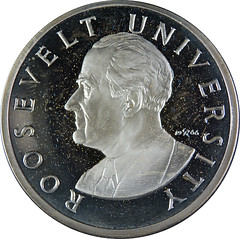
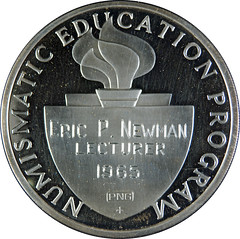
Chris Bower of Indianapolis writes:
I was fortunate enough to acquire this medal in a large lot of material sold during the last Newman auction by Heritage. I was kind of surprised that it was included in the lot as I would have thought it would have sold for enough individually to be in its own lot. It is in a box just like Ken Bressett mentioned in an earlier E-Sylum article.
When I finally discovered this piece, there were over 1000 pieces in the lot, I, of course, went to Google. Most of the hits directed me to E-Sylum articles from the past which didn't surprise.
Mr. Newman is one of my numismatic heroes so I am quite happy to have this in my collection.
Great acquisition! -Editor
To read the earlier E-Sylum articles, see:
THE ROOSEVELT UNIVERSITY COURSE IN NUMISMATICS (http://www.coinbooks.org/esylum_v13n34a17.html)
MORE ON THE ROOSEVELT UNIVERSITY COURSE IN NUMISMATICS (http://www.coinbooks.org/esylum_v13n35a16.html)
THE 1966 ANA PNG ARBITRATION HEARING AND ROOSEVELT UNIVERSITY (https://www.coinbooks.org/esylum_v13n35a17.html)
ROOSEVELT UNIVERSITY NUMISMATICS DIPLOMA (https://www.coinbooks.org/esylum_v17n17a13.html)
The Reason for the Season
Matt Hansen of Lincoln, Nebraska writes:
Just wanted to drop you a note to thank you for the final sentence in last week’s E-Sylum. Though many readers may glance over it and pay no regard to those words, it was not missed by this reader who values the tremendous message of truth contained therein, and appreciates very much its inclusion.
Merry Christmas
To read the earlier E-Sylum article, see:
THE CHRISTMAS STORY ON NOTGELD (https://www.coinbooks.org/v21/esylum_v21n50a26.html)

HOW MUCH 125 POUNDS IS WORTH TODAY
In an earlier issue we discussed the coin replicas produced by Robert Ready of the British Museum. “The prices set on 10 June 1882 were: Full set of Greek coins (800 pieces) £125." Charles Marsteller submitted this as an answer to the question, "How much would 125 pounds be worth today?" Thank you! -Editor
In 2017, the relative value of £125 from 1880 ranges from £11,830.00 to £205,600.00.
A simple Purchasing Power Calculator would say the relative value is £11,830.00. This answer is obtained by multiplying £125.00 by the percentage increase in the RPI from 1880 to 2017.
This may not be the best answer.
The best measure of the relative value over time depends on if you are interested in comparing the cost or value of a Commodity, Income or Wealth , or a Project.
If you want to compare the value of a £125 0s 0d Commodity in 1880 there are four choices. In 2017 the relative:
real price of that commodity is £11,830.00
labour value of that commodity is £58,730.00
income value of that commodity is £95,660.00
economic share of that commodity is £205,600.00
If you want to compare the value of a £125 0s 0d Income or Wealth , in 1880 there are four choices. In 2017 the relative:
real wage or real wealth value of that income or wealth is £11,830.00
labour earnings of that income or wealth is £58,730.00
relative income value of that income or wealth is £95,660.00
relative output value of that income or wealth is £205,600.00
If you want to compare the value of a £125 0s 0d Project in 1880 there are three choices. In 2017 the relative:
real cost of that project is £13,130.00
labour cost of that project is £58,730.00
economic cost of that project is £205,600.00
To read the earlier E-Sylum article, see:
MORE ON READY’S BRITISH MUSEUM REPLICAS (https://www.coinbooks.org/v21/esylum_v21n12a10.html)
VOCABULARY TERM: BIMETALLIC
Dick Johnson submitted this entry from his Encyclopedia of Coin and Medal Terminology. Thanks. -Editor
Bimetallic Bimetallic. A numismatic piece of two separate parts, each a different metal, usually one inset within the frame of the other; or one piece applied to a base medal, each of a different composition. The two metals are of contrasting colors to heighten the effect, as brass inset in a ring or frame of copper, white metal or aluminum. The inset is called a plug, particularly if it is heavier of the two metals or goes entirely through the piece and is exhibited on both sides. If it is only applied to one side it is called a center emblem (usually a thin metal shell).
Bimetallic Coins. The first bimetallic coin was struck in 1684 of James II in England. A square copper plug was placed in the center of a farthing struck in tin. It was dated on the edge – which corroded easily – making obscure the date of issues. Even so, this early bimetallic coinage was struck the following year as well.
In an attempt to bring the bullion value of a one cent coin up to face value, Henry Voigt at the newly formed U.S. Mint in Philadelphia in 1792 created patterns of a silver center cent. His experiment was to add a small plug of silver (worth 3/4 cent) to a bronze blank (worth 1/4 cent). After preparing a dozen or so samples he realized the impracticality of this idea.
The first modern coin in bimetallic composition was struck in Italy in 1982, a 500-lire coin with an outer ring in acmonital (stainless steel), with a bronze center. In 1992, The Paris Mint struck the first trimetallic alloy, a 20-franc coin. (This also became the first multimetallic coin.) Canada followed by experimenting with a bimetallic blank in 1995, and striking a bronze center in a copper-nickel frame for a $2 denomination. The blanks are made by private suppliers outside the mint. The popularity of bimetallic coins has spread to other countries including the United States.
Bimetallic Medals. In the mid 1890s several U.S. medal manufacturers, including August Frank of Philadelphia, offered a stock copper frame with a choice from dozens of stock inset center emblems, these were logos of fraternal organizations or sports event symbols. The custom continues today where shell insets are applied to a base medal; these are cheaply-made ribboned medals offered by trophy and medal houses, again mostly for sports awards.
Heeren Bros & Company of Pittsburgh developed a process (circa 1909) in which they partially plated a portrait struck on an aluminum piece (King 337-339). The plating was gold or copper to contrast with the aluminum. After several year's time, however, the plating leached onto the aluminum with tiny branch-like spikes giving an unattractive appearance to the piece. They applied for a patent for the process, but it did not succeed beyond these early somewhat experimental pieces.
In Europe a German manufacturer put center emblems of zodiac symbols in aluminum on the reverse of copper talismanic medals. {J&J 25:16534?}.
Bimetallic Tokens. Usually a brass plug set inside an aluminum frame, bimetallic tokens were struck in America for the first three decades of the 20th century. The concept of using two metals in a single token was to increase their security and prevent counterfeiting. Bimetallic tokens were numerous enough for numismatist David Schenkman to publish a list of these in 1990.
Other bimetallic techniques. Other two-color effects exist in numismatics, but it should be noted these do not employ two or more contrasting metal alloys. A number of noncirculating legal tender coins have been created with partial plating. An example is the gold plated device on the Republic of Minerva fantasy coin. These are not considered bimetallic.
Also, by using a stop off, a finish may be created where two or more color patinas are applied to the same piece by intent. However, this process should not be considered the same as parcel gilt (plating worn off to reveal base metal different color) and are not considered bimetallic.
When one metal and one or more nonmetallic compositions are used in the same piece, this is called mixed media, and are created for their artist content. These medallic items almost always have one metal component, plus plastic, wood, crystal, or other composition. These, obviously, are not bimetallic, even if two metal alloys are used plus one or more nonmetallic compositions.
In cataloging bimetallic items both compositions must be identified and mentioned.
Reference:
C67 {1988} Cooper, p 230.
Looking for the meaning of a numismatic word, or the description of a term? Try the Newman Numismatic Portal's Numismatic Dictionary at: https://nnp.wustl.edu/library/dictionary
Or if you would like a printed copy of the complete Encyclopedia, it is available. There are 1,854 terms, on 678 pages, in The Encyclopedia of Coin and Medal Technology. Even running two a week would require more than 19 years to publish them all. If you would like an advance draft of this vital reference work it may be obtained from the author for your check of $50 sent postpaid. Dick Johnson, 139 Thompson Drive, Torrington, CT 06790.

RICHARD WELLINGTON WILLIAMS (1853-1909)
 Richard Wellington Williams (1853-1909), was born on July 15, 1853, at Montreal, Québec, son of Richard Williams (1822-1854), an English immigrant and confectioner,
and Annie Gendle Williams (1827-1900). He was a chemist, druggist, and numismatist living at Trois-Rivières, Québec.
Richard Wellington Williams (1853-1909), was born on July 15, 1853, at Montreal, Québec, son of Richard Williams (1822-1854), an English immigrant and confectioner,
and Annie Gendle Williams (1827-1900). He was a chemist, druggist, and numismatist living at Trois-Rivières, Québec.
His father died when he was a child, and his mother remarried to Thomas Roderick Massey, J.P., of Nicolet County, Quebec.
In 1865, the family moved into the town of Nicolet, where he was educated and after graduation attended Nicolet College. This is the same college which had a coin collection containing the 1897 Unveiling of the Washington Monument Medal issued by the Cincinnati Society now in the Lupia Numismatic Library. It is possible Williams was the donor.
After graduating in 1870, he worked for a druggist in Three Rivers.
In 1874, he began collecting coins.
In 1875, he moved to Montreal, and studied at the Montreal College of Pharmacy. He graduated as a pharmaceutical chemist in 1877. He opened a drug store in Three Rivers 1878, where he establish his first business.
On October 9th, 1879, he married, Alice Jane Lamby (1856-1942), eldest daughter of John Thomas Lambly. They had six children a son, John Lewis Wellington Williams (1880-1952), and five daughters.
In 1886, he was elected one of twelve councillors of the Pharmaceutical Association of the province of Québec.
In January 1889, the partnership of Hoerner & Williams was dissolved due to the retirement of Mr. Hoerner. R. W. Williams continued the drug store under his own name.
On June 8, 1889, he joined the Numismatic and Antiquarian Society of Montreal.
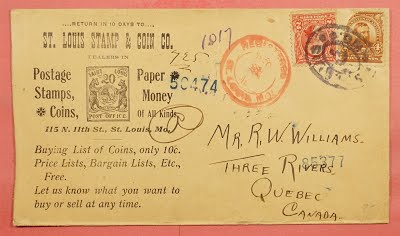
1903 correspondence with St. Louis Stamp & Coin Co.
He died on January 209, 1909. He is buried in Mount Royal Cemetery, Montreal, Quebec, Canada.
To read the complete article, see:
WILLIAMS, RICHARD WELLINGTON
(https://sites.google.com/a/numismaticmall.com/www/numismaticmall-com/williams-richard-wellington)
The entire inventory of the Lupia Numismatic Library is for sale. Individual items will be available before the remaining archives are broken up into parcels sold at philatelic auctions in the U. S. and Hong Kong. Check NumismaticMall.com frequently as dozens of new items with estimates will be posted daily until everything is sold.
All inquiries will be given prompt and courteous attention. Write to: john@numismaticmall.com .

HARVEY STACK'S NUMISMATIC FAMILY, PART 33
Harvey Stack's blog series focuses on growing up in a numismatic family. Here is part 33. Thanks, Harvey! -Editor
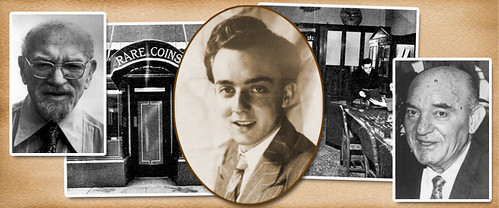
The year of 1962 had proved to be quite successful. We were pleased with the results of our first offering of the Samuel Wolfson Collection and we also had the feeling that 1963 would even be better, as there were several important offerings scheduled for our public auctions. In addition to having the Wolfson silver and copper coins already in house, we also had been tapped to sell the George Walton Collection, as Mr. Walton had died in a horrible accident the year before.
The numismatic community was growing with more new members joining clubs and the ANA, and attendance increasing at shows and conventions. Specialists vied for rarities and varieties from the 18th, 19th and 20th centuries. Competition for rare coins became keen and published price guides reflected the growth in interest.
Publications, including those published monthly and the weekly Numismatic News and the more recently started Coin World, had a great effect on the hobby. There was much information easily available, as well as advertising opportunities that were beneficial to both buyers and sellers. The two weekly publications were especially sought after and well used by collectors.
We still had to deal with the import regulations for world gold coins that were affecting the supply and availability of coins on this side of the ocean. As there was less to choose from, dealers and collectors began bidding more for gold coins of all series, both those from the United States and around the world. The prices in the Wolfson sale in October 1962 confirmed this increase in value. Stack’s was fortunate to have developed relationships with many collectors both established and new, and this resulted in our being able to find a lot of the items we needed for our customers.
Changes in the economy and increased ease of travel meant that collectors and investors could attend more auction sales, visit more coin shops, and go to more numismatic shows and conventions. This increase in activity naturally led to more money being spent in the hobby.
Our first major public auction sale for 1963 was The Samuel Wolfson Collection of United States Silver and Copper Coins. This portion was quite comprehensive for dates and mintmarks from 1793 to 1962 and featured many great rarities and highlights, a list of which would take a lot of space. Instead, I will focus on a major rarity the R. Coulton Davis 1804 silver dollar. This spectacular coin, along with the other coins in the collection, many of which were Proof or Mint State, attracted bidders in all series. Attendance was incredible, with about 500 collectors and dealers in a huge ballroom. In addition there were several thousand bid sheets and a record number of phone calls, all of which helped make the sale a great success.
The R. Coulton Davis 1804 silver dollar in the Wolfson Collection was a coin that we had first offered at auction in 1954 where it was bought by a collector who resided in Fairbanks, Alaska. It realized $8,000, a huge sum for a rare silver coin at that time. The Alaskan collector completed his silver dollar collection and decided to sell it at public auction through Stack’s in early 1960. At that sale, the 1804 dollar sold to Wolfson for $28,000, a new record price. At the 1863 Wolfson sale, it again set a new record, selling for $36,000.
In June of 1963 we offered the first part of the George Walton Collection, the largest holding of gold coins of the southern mints ever offered for sale. This included coins made by members of the Bechtler family, as well as those made at the Charlotte and Dahlonega mints. There were also numerous other gold coins from 1795 to 1932, a virtually complete collection of U.S. Mint gold coins. In my next article I will tell more about George Walton and how he built his collection.
To read the complete article, see:
Harvey Stack Remembers: Growing up in a Numismatic Family, Part 33 December 11, 2018
(https://www.stacksbowers.com/News/Pages/Blogs.aspx?ArticleID=3205)
To read the earlier E-Sylum article, see:
HARVEY STACK'S NUMISMATIC FAMILY, PART 32 (https://www.coinbooks.org/v21/esylum_v21n48a17.html)

TOM URAM APPOINTED CCAC CHAIR
Brandon Christopher Hall of Coin Update published an article December 17, 2018 about the appointment of Tom Uram to head the CCAC. See the full article online for more of the interview and photos of the committee and its members. -Editor
Thomas “Tom” J. Uram has recently been appointed by Secretary of the Treasury Steven Mnuchin to succeed Mary N. Lannin as chair of the Citizens Coinage Advisory Committee (CCAC) for a term of one year. Lannin will continue to serve as an active member of the CCAC. Uram has been a committee member of the CCAC since 2012 and was reappointed again by Speaker of the House Paul Ryan. In addition to being appointed as the new chair of the CCAC, he holds active roles as a governor of the American Numismatic Association (ANA) and president of the Pennsylvania Association of Numismatists.
Brandon Hall: What was your favorite coin or medal to help recommend a design for?

Citizens Coinage Advisory Committee member Thomas Uram (foreground) and U.S. Treasurer Jovita Carranza at a June 2017 CCAC meeting at Mint headquarters in Washington. (CCAC members Erik Jansen and Jeanne Stevens-Sollman in the background.) (Photo by Dennis Tucker.)
Tom Uram: It’s timely because I had the most influence on the selection of the Apollo 11 design. I was one of the three representatives from the CCAC who met with three other representatives from the U.S. Commission of Fine Arts. This was a unique selection since it was based on competition. I really felt the footprint was going to be the best design for all planchet sizes. It’s a super commemorative with the helmet on the obverse then the footprint on the reverse. We have the whole astronaut, head to toe.
Good luck Mary, and thanks for your service. Chairing the CCAC is a tough job requiring careful navigation of Congress, the Mint and the committee itelf, as well as the collecting community and coin industry, all tugging in different directions for their own interests and constituencies. Best of luck to Tom in his new role. -Editor
To read the complete article, see:
Treasury Secretary Mnuchin appoints Thomas J. Uram
to succeed Mary N. Lannin as CCAC chair (http://news.coinupdate.com/treasury-secretary-mnuchin-appoints-thomas-j-uram-to-succeed-mary-n-lannin-as-ccac-chair/)
THE BOOK BAZARRE
INTERVIEW WITH ANNE JESSOP OF THE ROYAL MINT
On November 29, 2018 Michael Alexander of the World Mint News Blog published an interview with Anne Jessop of the Royal Mint. Here's an excerpt; see the complete article online. -Editor
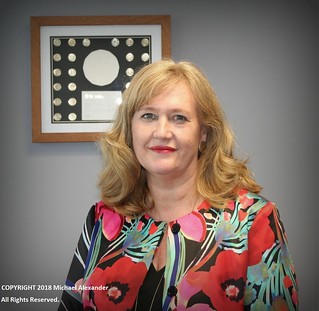 MA: The popularity of the Beatrix Potter coins took everyone by surprise and I suspect the programme was inadvertently expanded to include the last four characters this
year. The recent Paddington Bear series, the latest James Cook and RAF £2 series and more importantly the project of the A to Z 10-pence coins took a lot of collectors by
surprise. How did this set come about? Who’s idea was this? I’d like to give them credit where it’s due.
MA: The popularity of the Beatrix Potter coins took everyone by surprise and I suspect the programme was inadvertently expanded to include the last four characters this
year. The recent Paddington Bear series, the latest James Cook and RAF £2 series and more importantly the project of the A to Z 10-pence coins took a lot of collectors by
surprise. How did this set come about? Who’s idea was this? I’d like to give them credit where it’s due.
AJ: I’d say the A to Z set it was a team idea. We wanted to put something together that would allow people to collect out of their change and that’s why we chose the 10-pence denomination because we appreciate people can’t always take a pound or two pounds out of their change because this inevitably becomes expensive. We wanted to celebrate British life and we as a team thought that across the world people have launched other programmes which included a large number of coins and we, as a team, got together and came up with this idea and we’re really pleased with it. It’s gone incredibly well and got people talking about coins and that was a primary goal — for people to talk about coins.
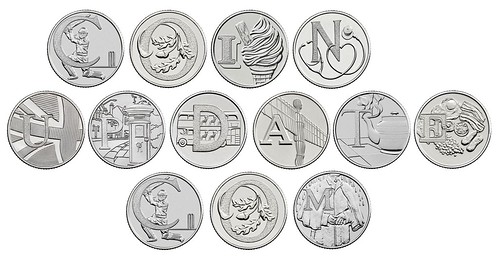
2018 10-pence coins
MA: I think it has created new collectors in the same way the United States did with the 25-cent State quarters coins, though I’ve not seen a single 10-pence coin in circulation myself. I have heard repeatedly that one of the frustrations with new collectors is that they “can’t find the coins in circulation” and have to buy packaged pieces from coin distributors at an increased price. With the success of the Royal Australian Mint and their arrangement with Woolworth’s which functions as a supermarket in Australia to distribute collector coin sets — would this be something the Royal Mint might consider?
AJ: As you’ll appreciate, the Treasury approves circulation coins which have a commemorative design, they order them from the Royal Mint and they tell us how many can be placed in circulation. I think as coins are ordered less in the future, there may be different ways that we can work on having different types of sets and how we can get them out to interested collectors. This is something that Nicola Howell’s (Director of Consumer Business) team is working on, she has taken over from me in the collector coins division and whether that includes a supermarket for instance as a direct point of sales, I can’t say, but it’s very much about thinking of different solutions.
Going back to the A to Z set, and listening to collector’s comments about packaging, when collectors ordered the coins directly from the mint, we didn’t use a lot of packaging which resulted in the least expensive option that was really quite reasonable. I think there are different ways we can think about that alternative in going forward.
To read the complete article, see:
An interview with Anne Jessop of the Royal Mint
(http://world.mintnewsblog.com/2018/11/an-interview-with-anne-jessop-of-the-royal-mint/)

COIN EXHIBITION IN PUNE, INDIA
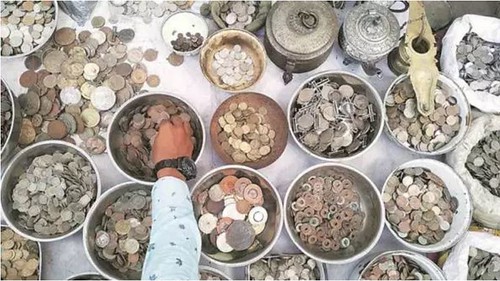
The city’s annual exhibition of rare coins was inaugurated by Dr Anand Shroff, an archaeologist and coin collector, at Sonal Hall on Karve Road on Friday. Coins and currency notes from all over the world, from different eras, were displayed in 35 stalls. Some of the highlights of the exhibition included a coin weighing 2 kg, coins in different shapes like guitar and lion, and a currency called ‘Beed’, which was in use 3,000 years ago. Visitors can buy coins from the stalls.
Shroff said that these ancient coins help us understand and study the life of people who lived in those time periods. “Coins are not just currency, they are the mirrors of an era,” said Shroff.
After the inauguration, four senior coin collectors, Shriniwas Bhat, Daulat Johri and Veena Sarasan, were felicitated by lifetime achievement awards for their contribution to the field.
The Oriental Numismatic Society, London and International Collectors’ Society of Rare Items also organised three lectures. Since 2018 is the 100th anniversary of the end of World War 1, an exhibition showcasing a collection of medals from the 18th century and from World War 1 is on display.
The exhibition also has a stall that is selling banned currency notes of Rs 500 and Rs 1,000 denominations, respectively for Rs 25 and Rs 50 per note. Hanuman Gaikwad, who is a collector and trader of old coins and currency notes, owns the stall.
“What is the use of them now? They are just a piece of paper. But, there are some people who are buying them just as a hobby. Maybe to tell their children and grandchildren about demonetisation. I sold a few. Now I might have one or two notes,” he said.
The three-day exhibition, which is open from 10 am to 7 pm, is on till December 16.
To read the complete article, see:
Exhibition on rare coins begins, provides window
into bygone eras (https://indianexpress.com/article/cities/pune/exhibition-on-rare-coins-begins-provides-window-into-bygone-eras-5494762/)
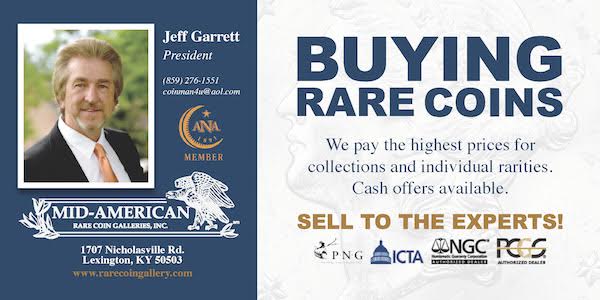
SELECTIONS FROM RAY CZAHOR MAILBID SALE XXII
At my request Ray Czahor provided some highlights from his Mailbid Sale XXII. First some information on the sale. -Editor
Mailbid XXII is finished and is being sent to everyone on my email and postal mailing list. The Maiilbid doesn’t close until 25 February 2019 so plenty of time to study and bid. The Mailbid List is 54 pages long and there are approximately 3080 lots.
Highlights are the 1540 coin lots containing significant varieties, Spanish issues, and the most extensive number of Republic commemoratives, sets, and business issues I have ever offered! Included are 270 medals and tokens lots including some SCARCE issues. Philippine under US paper money Issues include 360 lots, many SCARCE to RARE or seldom offered. WWII Guerrilla/Emergency collectors will have a large selection of lots (over 600) to choose from where several are RARE notes.
I have also added a special section of books and actual pyschological and propaganda leaflets and notes that were in the CM Nielsen collection—WWII, Vietnam, and Iraq wars. There are over 70 lots of Philippine and US Stamps including a number of old albums with stamps. Finally, there 120 book lots including several new editions that were published in the last few years for Philippine collectors. This is my largest sale ever and diverse in offerings. I would appreciate and hope that collectors do bid on lots of interest.
Ray Czahor
Cookie Jar Collectibles
PO Box 428
Savage, MD 20763-0428
Telephone: 301-604-9225
Email: cookiejarpi@verizon.net
Now for those highlights. -Editor
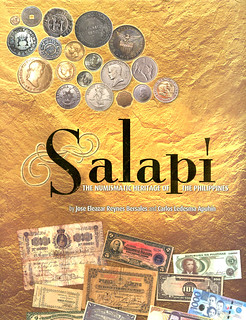
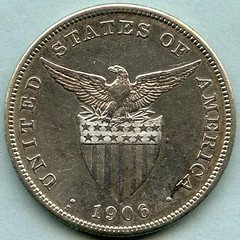
1. Salapi, a relatively new book privately published by the Bank of the Philippines and relatively not known in the US. Documents the history of both coins and paper money used in the Philippines since the 1500’s. Nice colored photos of most everything in the book.
Ray adds:
Great New Book Just Brought to USA: Bersales, Jose Eleazar Reynes & Carlos Ledesma Apuhim. Salapi/The Numismatic Heritage of the Philippines, 2014, privately printed by the BPI Foundation, Inc.. Large 9 1/4 by 12 3/8 inch format, Hardbound w/beautiful dustcover, 287 pages w/mostly color photos thoughout. Covers from the time of barter through the Spanish and US eras to the current Republic issues. The book weaves history and historical figures through each era covering both coins and paper money. Details are provided about each of the several Philippine & US Mints through their history. I was impressed with the effort that went into this book. Limited quantity available. Weighs 5 lbs.
2. A high grade 1906S Philippine Peso that still has some underlying luster. It is guaranteed Genuine vs several counterfeit ones seen on eBay and even a few encapsulated but fake.
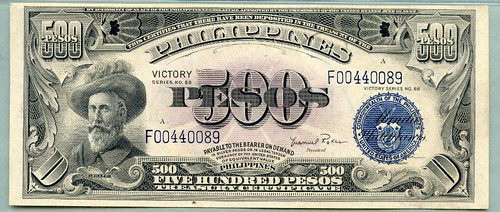
3. A very high grade and rare Pick 101c 500 Pesos Victory Note. This note was graded CU64 EPQ, very few graded that high.
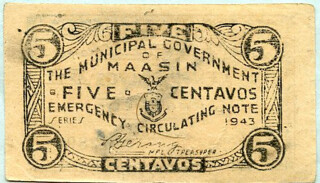
4. One of over 600 guerrilla/emergency notes in Mailbid XXII. This note is issued by the municipality of Maasin in Leyte Province during WWII. The AU grade is particularly high for such a note.

NUMISMATIC NUGGETS: DECEMBER 23, 2018
Here's a selection of interesting or unusual items I came across in the marketplace this week. Tell us what you think of some of these. -Editor
Naramore National Bank Note Cards

Naramore $1 - $50; $1000 Legal Tender; $1 - $1000 National Bank Note Cards with Partial Red Box; Naramore $50 Legal Tender; $1 National Bank Note Cards with "G.W. Thorne, U.S. Agent" Advertising.
This Pocket Edition set is missing the $100 and $500 Legals, but it has duplication of two pieces with what could be called "advertising notes." This was the first time that United States paper money had been officially photographed for distribution to the public. However, the government's consent was withdrawn shortly thereafter. The top and bottom flaps of the box are missing. The box also shows moisture damage. However, Naramore boxes in any shape are scarce. This partial box retains some of its bright overprinting. The item count for this lot is 18 cards plus one box. (Total: 19 items)
A classic item of U.S. numismatic literature as well as a great paper money collectible. From the Heritage January 2019 FUN sale. -Editor
To read the complete lot description, see:
Naramore $1 -
$50; $1000 Legal Tender; $1 - $1000 National Bank Note Cards with Partial Red Box;
(https://currency.ha.com/itm/miscellaneous/other/naramore-1-50-1000-legal-tender-1-1000-national-bank-note-cards-with-partial-red-box-naramore-50-l/a/3571-21944.s)
1787 Massachusetts Cent
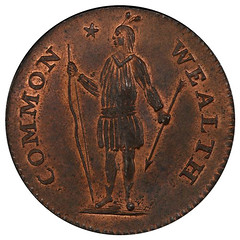
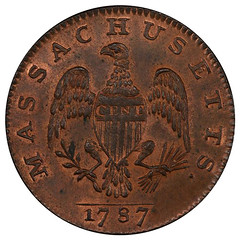
MASS *** This is without a doubt the finest Mass Cent in existence. One of only three to receive RB designation and the two in 64 are likely the same coin. This beauty has generous amounts of red on both sides and pristine, flawless surfaces. An amazing coin for the collector who seeks the finest. Must see to appreciate. This coin is really special.
I noticed this one in the inventory of E-Sylum supporter Harry Laibstain. -Editor
To read the complete lot description, see:
1787 CENT MASS, ARROWS IN MASS *** PCGS MS65RB (http://hlrc.com/Inventory/CoinViewer?id=869121001&c=23
1832 John Chapman Convict Love Token
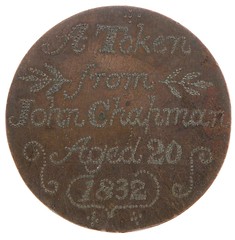
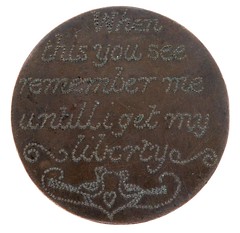
Description: Typical stippled inscription on a smoothed English Penny. Obverse reads "A Token from John Chapman Aged 20 1832" : Reverse inscription reads "When this you see remember me untill (sic) I get my liberty"
Dimensions: Diameter 36mm
Medium: Collectibles
Date: Coins, Monies & Stamps
Literature: 415
Notes: Convict Love Tokens have been romantically described as 'postcards before leaving' but they were really sad mementos of relationships torn asunder by the courts and the tyranny of distance. Most were crafted from smoothed English pennies and were inscribed with messages of love from a convict to a wife, lover or family that would most likely never see him again if he received a sentence of transportation. The subject of this token was John Chapman a 'waterman' of Middlesex, a petty criminal convicted in May 1832 of stealing a tea caddy in a shop robbery. After receiving his sentence of 14 years transportation to New South Wales he was sent to the prison hulk 'Retribution' moored at Woolwich where this token would have been fashioned. Chapman bore a tattoo of a woman flanked by the letters 'BC' and 'EP' on his right arm. Who the intended recipient of this token was is unknown, but his parting love is depicted by two kissing doves separated by a heart. Chapman left England on the 'Lord Lynedoch' on the 30th May 1833 arriving in the Colony of New South Wales on the 18th October 1833.
From the January 5, 2019 sale by Smalls Auctions in Paddington, Australia. -Editor
To read the complete lot description, see:
Lot 130: Australia. Convict Love Token dated 1832, Very Fine for issue
(https://www.invaluable.com/auction-lot/-1-c-9A643079F4)
Valentines Varnishes Medal
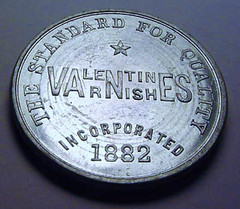
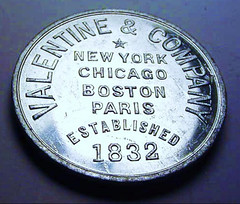
The intermingling of the letters in "Valentines Varnishes" in interesting and unusual. -Editor
To read the complete lot description, see:
Lot 271: VALENTINE VARNISHES ADVERTISING MEDAL (https://www.invaluable.com/auction-lot/-1-c-B684CE2858)
Bank of Ethiopia 500 Thalers
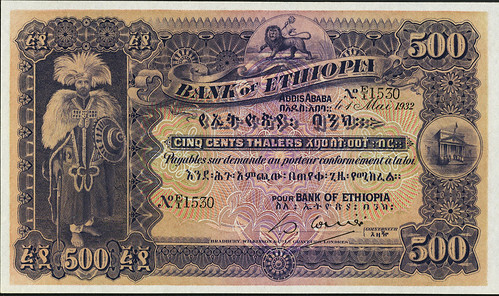
Ethiopia Bank of Ethiopia 500 Thalers 1.5.1932 Pick 11 PMG Choice Uncirculated 63.
This highest denomination in issued form, must be noted. Underprint colors are especially bold on both sides of this example. Large in size, as expected for this 500 Thalers. Warrior to left, the royal crest at center, and Bank building to right. The first E1 prefix is seen on this example with the first date of issue. This is the sole finest example of this type in the PMG Census by far. A truly magnificent early, and somewhat iconic example of African paper money. A not to be missed opportunity to own it. From the Minot Collection
Also from the Heritage January 2019 FUN sale. -Editor
To read the complete lot description, see:
Ethiopia Bank of Ethiopia 500
Thalers 1.5.1932 Pick 11 (https://currency.ha.com/itm/world-currency/ethiopia-bank-of-ethiopia-500-thalers-151932-pick-11-pmg-choice-uncirculated-63/a/4008-28569.s)
1935 Canadian Bank of Commerce Proof Five Dollar Note
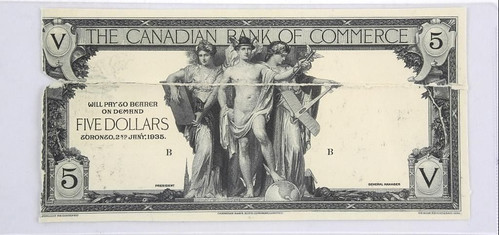
A classic design style. I just like it, despite the damage. -Editor
To read the complete lot description, see:
Bank of Commerce - January 1935 Proof Five Dollar Note.
(https://auction.auctionnetwork.ca/Bank-of-Commerce-January-1935-Proof-Five-Dollar-Note_i31982034)

MORE ON THE DAIRSIE HACKSILVER HOARD
Remembr the Dairsie hoard of late 3rd century hacksilver discovered last year? Archaeologists have been working to put the piece back together. Here's an excerpt from a Current Archaeology article. -Editor
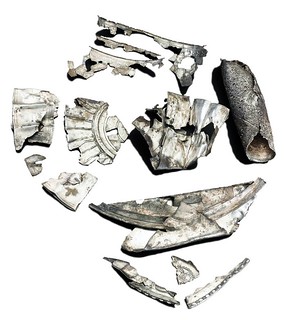 Recently discovered in Fife, the Dairsie Hoard represents the earliest-known evidence found outside the empire for Roman use of hacksilver to secure their frontiers.
Fraser Hunter unpicks its illuminating and ornate contents. These last few months have been spent in a form of devilish torment. Our museum conservators, helped and hindered by my
input, have been piecing together a silver jigsaw puzzle – pieces of Roman vessels, many only millimetres across. They have come together to reveal a remarkable find from Fife, on
the east coast of Scotland: a hoard of Roman hacksilver, the earliest known beyond the Empire’s edge, which casts fresh light on Roman frontier politics in the later 3rd century
AD.
Recently discovered in Fife, the Dairsie Hoard represents the earliest-known evidence found outside the empire for Roman use of hacksilver to secure their frontiers.
Fraser Hunter unpicks its illuminating and ornate contents. These last few months have been spent in a form of devilish torment. Our museum conservators, helped and hindered by my
input, have been piecing together a silver jigsaw puzzle – pieces of Roman vessels, many only millimetres across. They have come together to reveal a remarkable find from Fife, on
the east coast of Scotland: a hoard of Roman hacksilver, the earliest known beyond the Empire’s edge, which casts fresh light on Roman frontier politics in the later 3rd century
AD.
What is hacksilver? It is a term used for items, mostly silver vessels, which have been deliberately cut, chopped, and crushed into fragments – converted from beautiful works of art into a weight of silver. Although this habit has a long pedigree in the Old World, our main interest is with the Roman period.
The work of the late Kenneth Painter in particular has shown that this was no barbarian habit: hacksilver is found on both sides of the Roman frontier, especially in the north-western provinces, from the 2nd century AD to the 6th, though with a strong focus in the 4th and 5th centuries. Kenneth also showed that this silver was treated as bullion: much of it clearly correlated to multiples or fractions of Roman pounds and ounces, indicating the use of Roman weight standards. Either our barbarians were terribly careful with their brutal hacking, or there was a Roman economic motive behind this process – hacksilver was a process of turning objects into bullion at times of need.
One of those needs was dealing with barbarians. Hacksilver was sent north, whether as diplomatic gifts or payments for mercenary services, to Ireland, Denmark, the Netherlands, as far as Ukraine – and to Scotland. For a long time, this ‘barbarian’ hacksilver was seen as a phenomenon of the late 4th and 5th centuries AD. The new Fife find changes this. For the first time, we can see this policy of bullion payments starting earlier, in the late 3rd century.
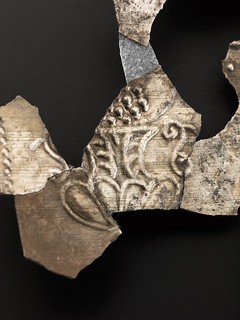
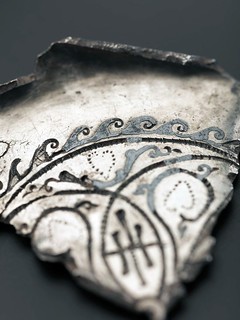
PIECES OF SILVER
The 408 fragments of silver that we recovered came from only four vessels in total, and the one least plough-scarred was the most puzzling of the lot: a silver cylinder of rather
thick metal, which preserves a rounded lip on part of its edge.
The final vessel is the most remarkable, but also the most difficult to reconstruct. It was made from thin, highly fragile silver, and seems to have been carefully placed, intact and upside down, to act as a cap to cover the rest of the silver. Unfortunately, this arrangement left it extremely vulnerable to the plough, and the base has been almost totally lost, but most of the rim survives.
To read the complete article, see:
Solving a silver jigsaw: A new hoard of Roman hacksilver
from Fife (https://www.archaeology.co.uk/articles/solving-a-silver-jigsaw-a-new-hoard-of-roman-hacksilver-from-fife.htm)
To read the earlier E-Sylum article, see:
DETECTORIST UNCOVERS ROMAN HACKSILVER HOARD (https://www.coinbooks.org/v20/esylum_v20n33a28.html)

HUNGARY COMPLETES BANKNOTE REDESIGN ROLLOUT
Hungary has completed the replacement of its older banknotes with newer upgraded versions. -Editor
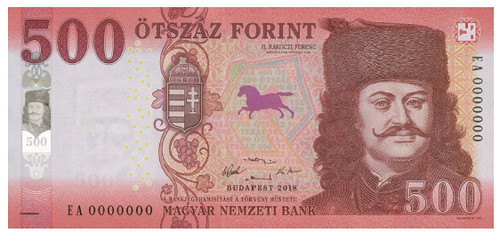
New 500-forint bills will be put into circulation in Hungary on 1 February 2019, and the old banknotes may be used for payment until 31 October next year, the central bank (MNB) announced on Monday.
The 500-forint notes will remain an official means of payment until 31 October 2019, after which the MNB will have them withdrawn from circulation, and only the new 500-forint bills may be used for payment after that.
The central bank started to replace banknotes in 2014. The previous series was issued in 1997. Each of the new banknotes depicts the same persons and locations on their obverse and the reverse, respectively. Only the placement and size of the texts were changed besides the colours. The new banknotes also have additional security features which makes it even more difficult to forge them.
We have collected the old (left) and new (right) bank notes, both the obverses and reverses. We believe the pictures speak for themselves and clearly prove speculation wrong that the two series are easy to mix up.
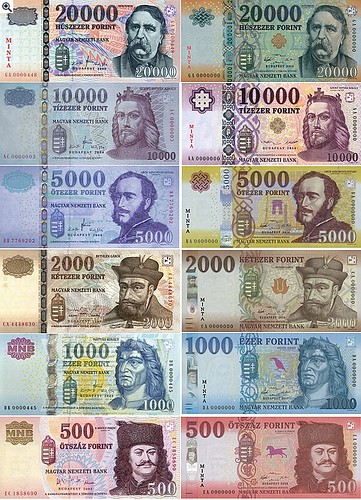
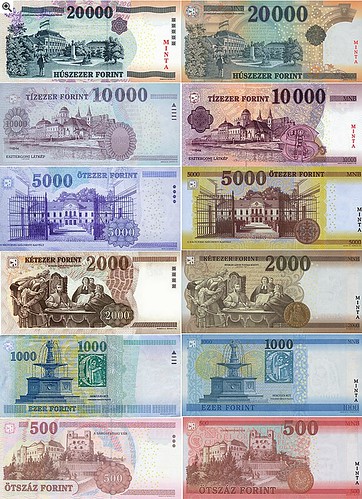
To read the complete article, see:
Here comes Hungary's new 500-forint banknote
(http://www.portfolio.hu/en/economy/here-comes-hungarys-new-500-forint-banknote.38115.html)
For more information on the notes, I reached out to reader Dave Hirt who is currently in Budapest. Thanks. -Editor
Dave writes:
My wife Emi saw on the TV news about the new 500Ft note the same day you sent me this. This note, the lowest denomination of paper money completes the redesign of Hungarian paper money which started over a year ago. I believe the new notes have more security features in them. As far as I know the new notes have been well accepted.
THE BOOK BAZARRE
LOOSE CHANGE: DECEMBER 23, 2018
Here are some additional items I came across in the media this week that may be of interest. -Editor
Anastasios G. Leventis Collection Exhibit
The The A. G. Leventis Gallery in Nicosia, Cyprus has mounted a display of coins collected by its founder. -Editor
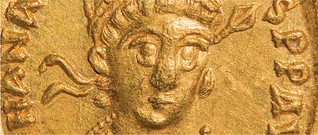 The Leventis Gallery presents for the first time to the public a selection of rare coins from the previously unknown collection of coins by Anastasios G. Leventis. The
Levente Gallery's Collection of Coins contains rare examples of special interest for both collectors and academics and researchers. With this exhibition, not only is the
collection presented to the academic public, but also visitors will have the opportunity to see exhibits that have been a milestone in the world history of mints.
The Leventis Gallery presents for the first time to the public a selection of rare coins from the previously unknown collection of coins by Anastasios G. Leventis. The
Levente Gallery's Collection of Coins contains rare examples of special interest for both collectors and academics and researchers. With this exhibition, not only is the
collection presented to the academic public, but also visitors will have the opportunity to see exhibits that have been a milestone in the world history of mints.
The curators organize an exhibition of 12 coins -which are dated by Alexander the Great, Byzantium, the Middle Ages to the early modern era- together with a selection of objects from the general history, giving visitors the opportunity to get to know and appreciate better the general socio-historical context associated with the history of mints. With this approach, significant historical events, the era of great kings and emperors, international politics, economic and commercial situations, and all the complexities behind the world minting are revealed through the report. Through new technologies, an opportunity will be given, in particular to new visitors, to find out more and more interesting aspects of the history of mints.
To read the complete article, see:
Gold Stories (https://www.leventisgallery.org/whats-on/events/243)
Moon Landing Coin First Strike Ceremony
CoinWeek published an article about last week's first strike ceremony for the 2019 Apollo 11 Moon Landing 50th Anniversary coins. It also has a link to a video of the ceremony. Check it out. -Editor
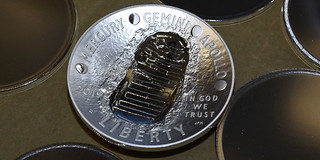 On Thursday, December 13, the United States Mint held a striking ceremony for the 2019 Apollo 11 Moon Landing 50th Anniversary Commemorative silver and gold coins.
Several invited guests–including the children of the first men to set foot on another world: Buzz Aldrin’s son Andy Aldrin; Michael Collins’ daughter Ann Starr; and Neil
Armstrong’s son Mark Armstrong–made ceremonial first strikes of the five-ounce and regular weight silver Proof 2019-P Moon Landing commemoratives.
On Thursday, December 13, the United States Mint held a striking ceremony for the 2019 Apollo 11 Moon Landing 50th Anniversary Commemorative silver and gold coins.
Several invited guests–including the children of the first men to set foot on another world: Buzz Aldrin’s son Andy Aldrin; Michael Collins’ daughter Ann Starr; and Neil
Armstrong’s son Mark Armstrong–made ceremonial first strikes of the five-ounce and regular weight silver Proof 2019-P Moon Landing commemoratives.
To read the complete article, see:
United States Mint Holds 2019 Apollo 11 Moon Landing Commemorative Coin First
Strike Ceremony (https://coinweek.com/us-mint-news/watch-the-2019-apollo-11-coin-first-strike-ceremony/)
2018’s Most Profitable Modern Coins
Lou Golino published a CoinWeek article December 14, 2018 on "2018’s Most Profitable Modern Coins." Here's an excerpt - be sure to read the complete article online. -Editor
Modern coins frequently “pop and drop”; i.e., they sell for a premium while they’re hot (typically right after they sellout from their issuing mint or distributor), and then prices recede as interest in the item cools down.
But there are always some releases that retain solid aftermarket premiums months and even years after their release. Good examples include the Tiffany Art series of two-ounce and one-kilo silver pieces and the Austrian 25-euro niobium-silver series.
In 2018 there were as usual both collector and bullion world coins that did well, though in general, they saw smaller gains than pieces from previous years.
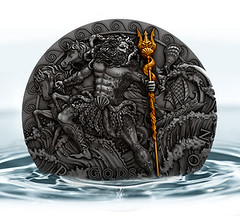 On the numismatic coin front, the clear winner was the second release in the Polish Mint’s series for Niue called “Gods”, which debuted in 2017 with a coin for Ares that
continues to sell for $1,100 or more and which was initially available for about $250-300, depending on the retail seller.
On the numismatic coin front, the clear winner was the second release in the Polish Mint’s series for Niue called “Gods”, which debuted in 2017 with a coin for Ares that
continues to sell for $1,100 or more and which was initially available for about $250-300, depending on the retail seller.
To read the complete article, see:
The Coin Analyst: 2018’s Most Profitable Modern Coins
(https://coinweek.com/modern-coins/the-coin-analyst-2018s-most-profitable-modern-coins/)
When Massachusetts Banned Christmas
Here's a fascinating short video explaining the 22-year ban on Christmas enacted by the Massachusetts Bay Colony in 1659. Back then the Puritans despised Christmas, which was
associated with debauchery, according to the video. Christmas encouraged people to drink "copious amounts of alcohol," riot in the streets, gorge on food (gasp!), and
was the catalyst of rowdiness and sinful behavior.
In other words, Christmas, back then, was not considered to be family friendly. "But in the end," the narrator states, "we can partially thank commercialization for sustaining the domestic brand of Christmas we have today." Yippee?
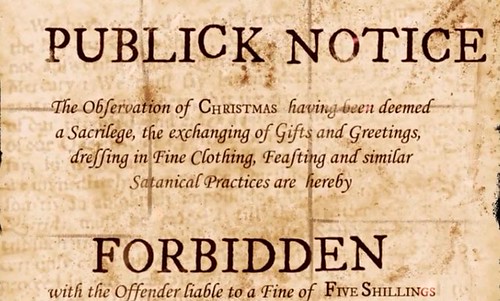
To watch the video, see:
When Christmas was despised and banned for 22 years in Massachusetts
(https://boingboing.net/2018/12/21/when-christmas-was-despised-an.html)
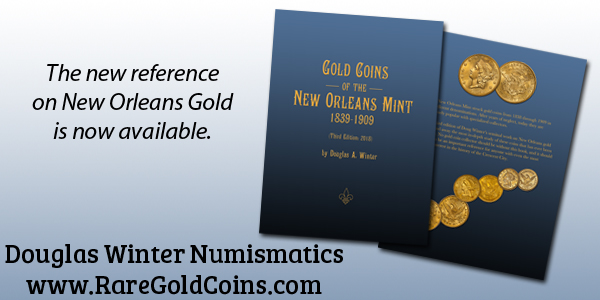
WAYNE'S NUMISMATIC DIARY: DECEMBER 23, 2018
I've been too busy lately to keep up with my numismatic diary, but I wanted to show these photos of two neat items of Christmas-themed numismatic ephemera. Given to me by Howard Daniel via Wayne Herndon at our November 2018 Nummis Nova dinner, they are Christmas ornaments issued by Krause Publications. The second one is perfect for the bibliophile - a miniature Standard Catalog to hang on your tree! Thanks, Howard!
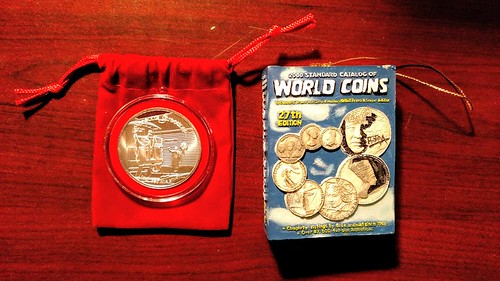
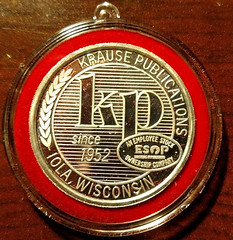
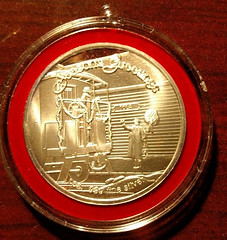

AAS ACQUIRES FIRST ILLUSTRATED VISIT FROM ST. NICK
For bibliophiles and all the collectors among us, here's a delightful Christmas story of a decades-long acquisition wish finally fulfilled. From the American Antiquarian Society blog Past is Present. -Editor
Not so long ago I got a phone call from AAS member David Doret (elected 2009), telling me that he had a Christmas book of potential interest. It was what seemed to be the first fully illustrated book-length edition of Clement Clarke Moore’s classic Christmas poem A Visit from St. Nicholas, better known as “The Night before Christmas.” Although Moore’s poem was first published in an 1823 issue of the Troy Sentinel newspaper and had appeared in children’s poetry anthologies, it was not until 1848 that the poem commanded center stage as the subject of its own picture book replete with wood engravings by Theodore C. Boyd. It was published in New York by Henry M. Onderdonk, who issued various publications for the Protestant Episcopal Church and was likely well acquainted with Moore, who was a professor of Divinity at the Episcopal General Theological Seminary in New York. It is a humble square book of sixteen pages, cheaply bound in a paper wrapper emblazoned with the title “Santa Claus.”
I listened to David with great interest. I had been on the prowl for this little book during my entire thirty-year tenure at AAS, and my collecting predecessor, former AAS director Marcus McCorison, had been eagerly searching for it for some decades before that. It was always in the back of my mind as I perused catalogs from book dealers and auction houses, but it was eerily absent. The truth of the matter is that only a handful of copies of the 1848 edition of Visit survive in institutional collections. Even in the 2006 Sotheby’s catalog devoted to Jock Elliott’s Christmas Collection—a collection compiled over half a century by the late chairman emeritus of the advertising firm Ogilvy & Mather—the 1848 Onderdonk edition of Visit is nowhere to be found. A copy of the 1823 Troy Sentinel issue containing the famous poem, however, was listed with a starting bid of between ten and twenty thousand dollars; I can only guess what a copy of this little book with its Santa pictures would have fetched, had it been available.
Happily, the copy that David sent us was contemporary to 1848, with its slightly foxed paper stock and tiny stitches made by a former owner mending a tear at the spine, and as of today AAS can count itself among the few institutions to hold a copy of this coveted book.
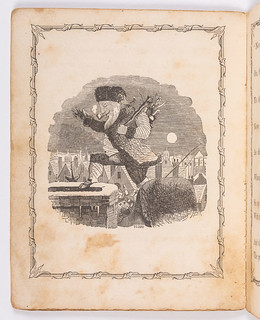
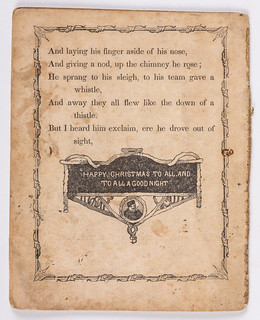
To read the complete article, see:
An Early Christmas Gift: The First
Illustrated Edition of A Visit from St. Nicholas
(https://pastispresent.org/2018/good-sources/an-early-christmas-gift-the-first-illustrated-edition-of-a-visit-from-st-nicholas/)

THE TWELVE COIN COLLECTING DAYS OF CHRISTMAS
I thought I would celebrate Christmas this year by trying to find twelve coins to illustrate the famous song. What would you have chosen? This is not perfect and as we say in Britain you sometimes have to compromise. Happy Christmas to collectors everywhere.
On the first day of Christmas, my true love gave to me A partridge in a pear tree
1993 Gibraltar 1p coin One Penny Pence BARBARY PARTRIDGE
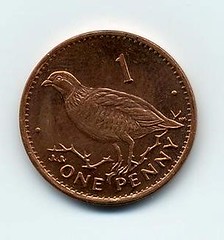
The Barbary partridge (Alectoris barbara), on a Gibraltar 1 penny.
By Source, Fair use, https://en.wikipedia.org/w/index.php?curid=12428501
On the second day of Christmas, my true love gave to me Two turtle doves and a partridge in a pear tree

The silver Five "Pence" Obverse: A dove flying with an olive branch in its beak. Reverse: IIIII between two lines above and below with inscription GRIQUA (above) TOWN (below and upside down). Average diameter: 20.96 mm. Average thickness: 0.66 mm. Average mass: 2.37 gram. Edge: Reeded obliquely
This file is licensed under the Creative Commons Attribution-Share Alike 4.0 International license.
On the third day of Christmas, my true love gave to me three French hens
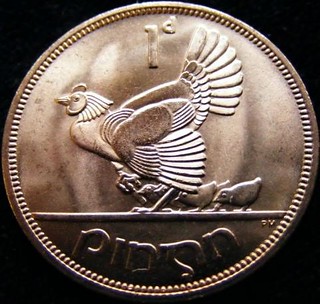
Ok not a French hen. This is an Irish hen on a penny designed by Percy Metcalf.
By RMUCD - Own work, CC BY-SA 4.0, https://commons.wikimedia.org/w/index.php?curid=44900382
On the fourth day of Christmas, my true love gave to me Four calling birds, three French hens, two turtle doves And a partridge in a pear tree
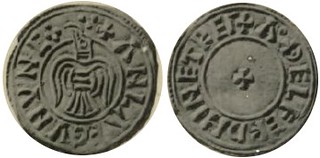
The Raven Penny is a coin of the Viking Olaf Guthfrithson who was the king of Dublin between 934-941.
Calling birds is actually colly birds or blackbirds. A raven was the closest I could get.
On the fifth day of Christmas, my true love gave to me
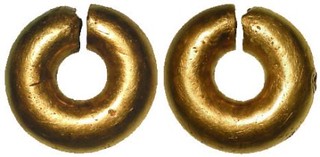
Celtic Ring Money
Before coinage was introduced to Britain in the Late Iron Age, people had to conduct transactions by bartering their products, goods and/or services. This process of payment and
exchange may have been facilitated by gold “ring money”
Five golden rings, four calling birds, three French hens Two turtle doves and a partridge in a pear tree
On the sixth day of Christmas, my true love gave to me Six geese a-layin', five golden rings, four calling birds
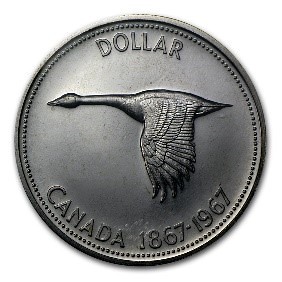
1967
The centennial dollar
Alex Colville created a special set of coin designs to commemorate the 100th anniversary of Canadian Confederation; the 1-dollar coin features a Canada goose. After 1967,
circulation 1-dollar coins were made of nickel until 1987, when the 'loonie' was introduced.
Three French hens, two turtle doves and a partridge in a pear tree
On the seventh day of Christmas, my true love gave to me Seven swans a-swimmin', six geese a-layin', five golden rings
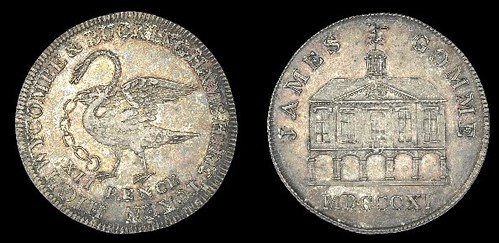
The swan is a symbol of Buckinghamshire so I choose a local token.
The Collection of British Tokens formed by John Roberts-Lewis BUCKINGHAMSHIRE, High Wycombe, James Gomme, Shilling, 1811, swan chained, rev. view of the Town Hall, edge grained, 3.72g/12h (D 1). About extremely fine, toned £80-100
Image used by kind permission of DNW
Four calling birds, three French hens, two turtle doves And a partridge in a pear tree
On the eighth day of Christmas, my true love gave to me Eight maids a-milkin', seven swans a-swimmin'
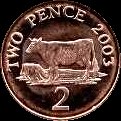
By Source, Fair use, https://en.wikipedia.org/w/index.php?curid=27603656
I could not find any maids a milking but here is a Guernsey cow they could milk.
Six geese a-layin', five golden rings, four calling birds, three French hens Two turtle doves and a partridge in a pear tree
On the ninth day of Christmas, my true love gave to me Nine lords a-leapin', eight maids a-milkin', seven swans a-swimmin'
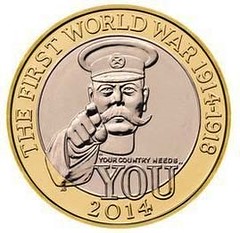
Only one Lord, this is Lord Kitchener.
Six geese a-layin', five golden rings, four calling birds, three French hens Two turtle doves and a partridge in a pear tree
On the tenth day of Christmas, my true love gave to me Ten ladies dancin', nine lords a-leapin', eight maids a-milkin'
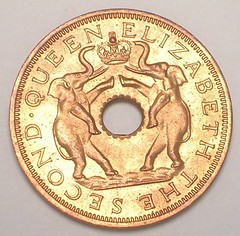
Ladies dancing was a bit of a challenge and here are some elephants dancing.
Seven swans a-swimmin', six geese a-layin', five golden rings Four calling birds, three French hens Two turtle doves and a partridge in a pear tree
On the eleventh day of Christmas, my true love gave to me Eleven pipers pipin', ten ladies dancin', nine lords a-leapin'
This was another challenge. I found this very rare coin featuring pan pipes.
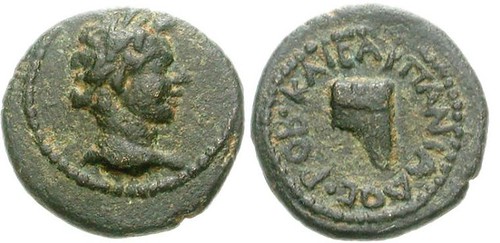
Caesarea Panias (Trachonitis), Syria, AE15, time of Marcus Aurelius. 2.87 g. 169 AD.
Head of Pan right KAICAP PANIA DOC POB, syrinx (Pan pipes). SNG ANS 860; Meshorer Caesarea Pania, 2.
Used with permission of Classical Numismatic Group, Inc., Website
http://www.cngcoins.com
Eight maids a-milkin', seven swans a-swimmin' Six geese a-layin', five golden rings, four calling birds, three French hens Two turtle doves and a partridge in a pear tree
Twelve drummers drummin', eleven pipers pipin', ten ladies dancin'
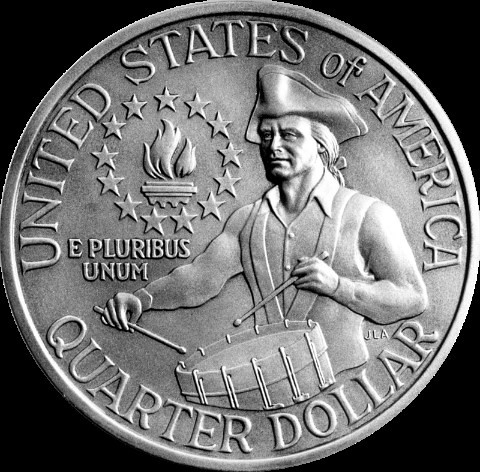
Quarter Bicentennial reverse: drummer
By United States Mint - United States Mint, Public Domain,
https://commons.wikimedia.org/w/index.php?curid=687348
Nine lords a-leapin', eight maids milkin', seven swans a-swimmin' Six geese a-layin' five golden rings, four calling birds, three French hens Two turtle doves and a partridge in a pear tree
Happy Christmas
Note: I have tried to obtain permissions for all illustrations. Grateful thanks to all who gave permission.
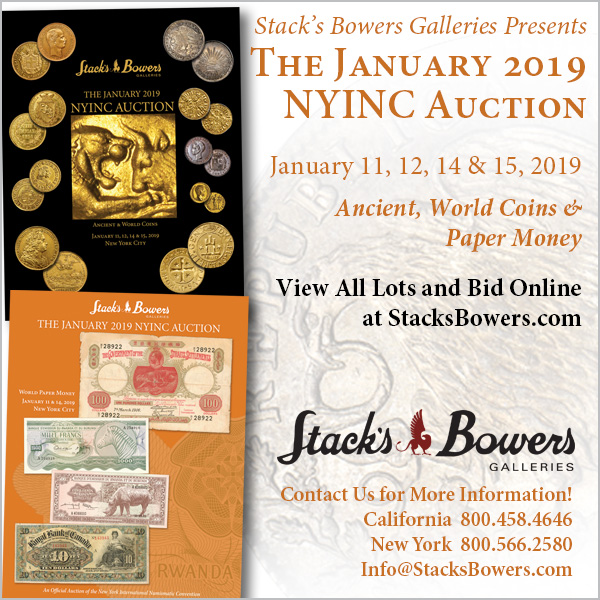
OXFORD NUMISMATIC SOCIETY CHRISTMAS GREETING
Also sent by David Pickup is this nice Christmas greeting from the Oxford Numismatic Society. -Editor
Merry Christmas from the President, Secretary and
members of the Oxford Numismatic Society.
Have a very fine and extremely rare Christmas.
And a well struck, scarce and just minted, Happy New Year.

(left to right)
King William I (1066-1087),
Lot 87 Date of Auction: 18th September 2018
Sold for £1,200 Estimate: £1,500 - £1,800
The Collection of British Coins Formed by the Late Ray Inder Penny, Profile Left type, Oxford, Ælfwig, ælfpi on oxenei, 1.19g/12h (Allen, BNJ 2012, —; N 839; S
1250). Very fine and extremely rare; an unrecorded type for this moneyer
King Charles I (1625- 1649)
Lot 479 Date of Auction: 14th November 2018
Sold for £600 Estimate: £500 - £700
English Coins from the Collection of the late Dr John Hulett Oxford mint, Shilling, 1643, mm. Oxford plume on obv. only, large bust, rev. Declaration in large letters,
reads pro, three Oxford plumes above, date below, 5.99g/9h (Morr. D-1; SCBI Brooker 932; N 2444; S 2972). Reverse die too large for the flan, very fine and toned, rare
Provenance: Bt S. Mitchell September 2011
King Henry II (1154-1189),
Lot 168 Date of Auction: 18th September 2018
Sold for £90 Estimate: £90 - £120
The Collection of British Coins Formed by the Late Ray Inder. Short Cross coinage, Penny, class Ib1, Oxford, Iefrei, iefrei · on · oxene, 1.40g/5h (SCBI Mass 447, same dies; N 963; S 1344). Cleaned and a small scrape on obverse, otherwise very fine, scarce
All images and text used by kind permission of © Dix Noonan Webb

Thank you, and a Merry Christmas to all. -Editor

